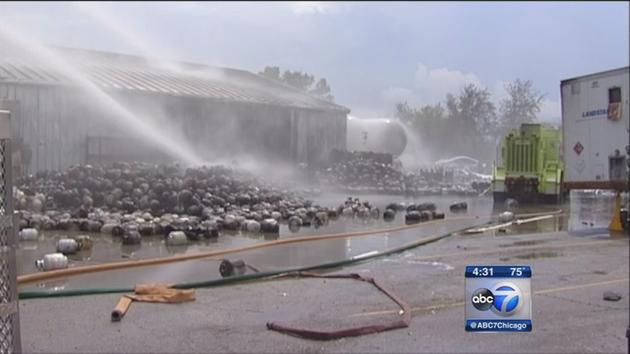|
An
OSHA investigation of the incident resulted in allegations that the
employer’s process safety management (PSM) program was woefully incomplete.
Arboris had completed some aspects of PSM required by OSHA, but its program
had significant gaps—and in those gaps were the makings of disaster. Take a
close look at your own PSM program, and make sure you haven’t missed any of
these preventive measures.
Complete Your Process
Safety Information
Arboris
was cited for multiple violations of 29 CFR 1910.119(d), which requires
employers to develop complete process safety information for use in the
development of safety practices and procedures. Arboris allegedly did not
have complete information for its process with respect to:
- The
maximum intended inventory. There was no record of how much inventory
the system could handle.
- Safe
upper and lower limits for temperature, pressures, flows and
compositions. Without a maximum intended inventory, there was no way to
adequately determine this information.
- An
evaluation of the consequences of deviations from safe limits in the
process. If you haven’t determined what the limits are, it’s impossible
to determine what deviations might do.
- Accurate
piping and instrumentation diagrams (P&ID). According to the
existing P&ID, the relief piping on the tank that exploded vented to
the ground, when, in fact, it did not.
- Its
relief system design and design basis. There should be some evaluation
of how the relief system is supposed to work.
- Design
codes and standards employed. What information was used in developing
the system design? The information the employer had in this case did not
match the system as designed.
- Safety
systems. There was no information in the employer’s process safety
documentation about foam suppression systems, flame arrestors,
interlocks, level indicators, or lower explosive limit (LEL) meters.
- Recognized
and generally accepted good engineering practices (RAGAGEP). OSHA
alleges that Arboris failed to document that nine different components
of the process were installed in accordance with good engineering
practices.
Without
complete process information, Arboris lacked what it needed to ensure that
the process was properly designed and operating within safe limits.
Action item: Is your
process safety information complete and current?
Complete Your Process
Hazard Analysis
Arboris
was also cited for multiple violations of 29 CFR 1910.119(e) requiring
employers to perform a process hazard analysis (PHA), which must be
periodically updated. Arboris had performed a PHA, but it was incomplete. The
PHA allegedly failed to:
- Identify
all potential worst-case scenarios that could lead to an
overpressurization of its process.
- Identify
the potential for the hexane solvent wash to rapidly boil under upset
conditions.
- Identify
the potential hazards of material build-up in the relief pipe.
Arboris
also allegedly failed to analyze and characterize the hazards created by
facility siting in both its initial PHA and follow-up PHAs. Neither PHA
addressed facility siting at all. A complete PHA of facility siting should
examine the hazards of location, unit layout, storage/warehouses, spacing
between process components, control rooms, occupied buildings, unit location
relative to surroundings, emergency stations, contingency planning,
electrical classification, ventilation, location of emergency relief venting,
and evacuation routes through perimeter fencing surrounding the covered
process.
Of course,
when your PHA is finished, you must arrange to address any items of concern
that have been identified. Arboris allegedly also failed to do this; it had
no system to promptly address its PHA findings and recommendations, assure
that they would be addressed in a timely manner, and document those actions.
Action items: Does your
PHA cover all possible worst-case scenarios and dangerous chemical reactions,
as well as the hazards inherent in your location and layout? Have you
addressed your findings? Have you communicated the findings and your
corrective measures to process operators?
Develop Safe Operating
Procedures
This is
the point where the rubber met the road at the Arboris plant. There does seem
to have been a written set of operating procedures in place, but workers were
not following it when they added hexane wash to the melt tank—the event that
led directly to the explosion.
The
workers may not have been following the procedures because the procedures
themselves were incomplete, failing to cover all possible situations in
violation of 29 CFR 1910.119(f). Specifically, the written procedures did not
cover:
- Temporary
operations.
- Startup
following a turnaround or emergency shutdown.
- Consequences
of deviation. In this case, OSHA noted that the procedures did not cover
the consequences of adding hexane to the process before it reached the
optimal temperature.
- Steps
required to correct or avoid deviation.
- Safety
systems and their function.
- Special
situations, such as lockout/tagout, confined space entry, pipe
breaking/line breaking operations, and the presence of workers not
directly involved in the operation in the work area.
- Annual
review of the operating procedures.
Action items: Do your
operating procedures cover all
operating conditions, not just “normal production”? Do they give operators
the information they will need to correct problems that might arise before
they lead to disaster?
Manage Any Changes
Any time
you make changes to a covered process other than to replace existing parts or
ingredients with essentially similar ones, you must examine the changes from
all angles in order to make sure that the process will remain safe. On the
day of the fire, Arboris workers used a different chemical in their
process—isohexane, rather than the designed n-hexane—but it appears that no
one stopped to ask whether the change was safe.
Action item: Ensure that
you have written management-of-change procedures, and that operators
understand that any changes to the process must be managed using those
procedures.
Tomorrow,
we’ll look at six more gaps that OSHA identified in Arboris’ PSM program that
could have helped to prevent the fire.
|






































